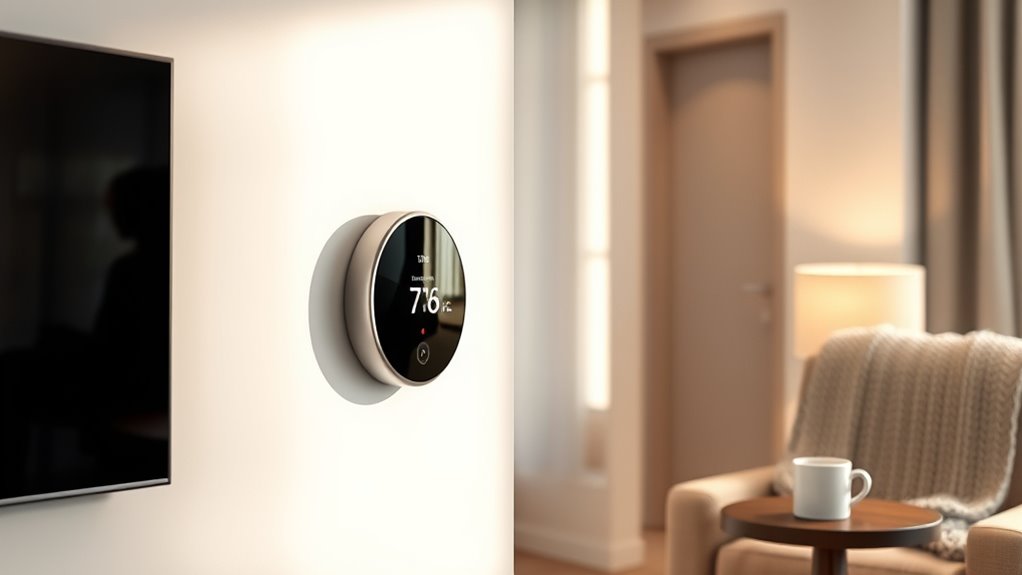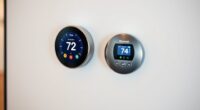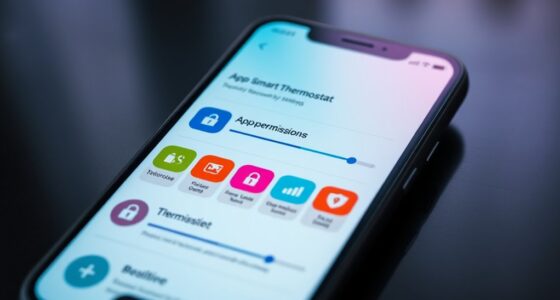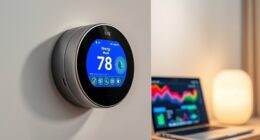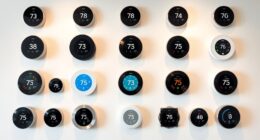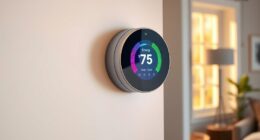Smart thermostats collect detailed data about your routines, preferences, and home environment, which raises privacy concerns. They track activities like voice commands, energy use, location, and habits, often sharing this information with manufacturers or third parties without clear consent. This can expose personal habits and compromise security. To protect yourself, you should review privacy settings and choose devices with strong security features. If you keep exploring, you’ll discover ways to better safeguard your privacy.
Key Takeaways
- Smart thermostats collect detailed data on routines, occupancy, and preferences, raising concerns about personal privacy and data misuse.
- Data shared with manufacturers or third parties can lead to targeted advertising and potential privacy breaches.
- Vulnerabilities like weak security measures increase risks of hacking, unauthorized access, and home security compromises.
- Lack of transparency in data collection practices and limited user control over personal data heighten privacy concerns.
- Evolving AI capabilities and data collection methods pose future privacy challenges, including profiling and unauthorized surveillance.
Understanding the Data Collection Process of Smart Thermostats
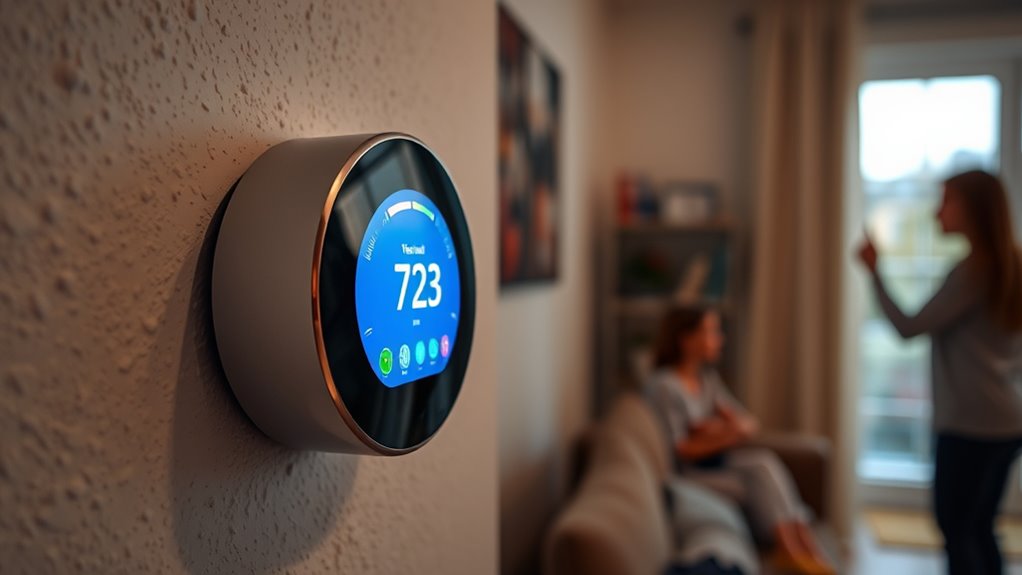
Smart thermostats collect data by continuously monitoring your temperature settings, occupancy patterns, and environmental conditions within your home. This process relies on device integration, where the thermostat communicates with other smart devices to gather detailed information. To protect your privacy, manufacturers often implement data anonymization techniques, which strip personally identifiable details from the collected data. This helps guarantee that your usage patterns are stored securely and cannot be traced back to you individually. Additionally, digital literacy programs can help users better understand how their data is managed and protected. Educating users about privacy features empowers them to make informed decisions regarding their smart home devices. Understanding this data collection process reveals that smart thermostats are designed to optimize comfort and energy savings while prioritizing your privacy through careful data handling measures like device integration and anonymization. Recognizing the importance of cybersecurity measures can further enhance user trust and safety in smart home technology.
Types of Personal Information Gathered by These Devices
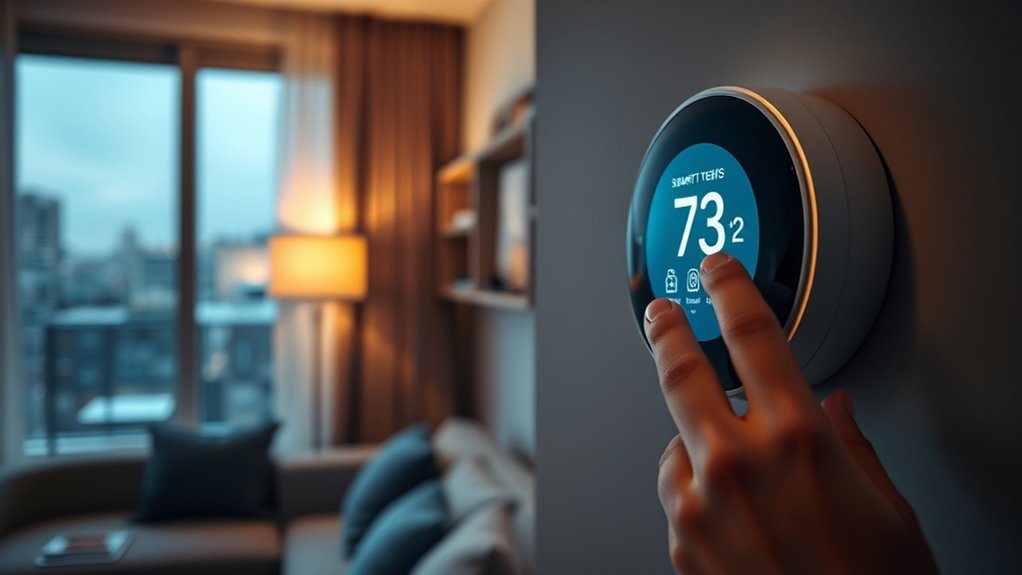
While smart thermostats are designed to enhance home comfort and efficiency, they also collect various types of personal information. First, they record your voice commands, which reveal your daily routines and preferences. Second, they track your energy consumption, providing data on when and how you use heating or cooling. Third, they monitor your daily schedule, including times you’re home or away, based on temperature adjustments. Fourth, they gather data on your location, either through Wi-Fi or geofencing, to optimize comfort as you come and go. All these details paint a detailed picture of your habits and lifestyle, raising privacy concerns. Understanding what information these devices collect helps you better assess potential risks and make informed decisions about your smart home setup. Additionally, cost and budgeting considerations can influence whether you opt for high-end or budget-friendly smart thermostats, impacting the scope of data collection and privacy implications. Moreover, the regulatory environment surrounding IoT devices is evolving, which could affect how your data is protected and managed. Furthermore, the increasing use of AI-driven data analysis allows for more accurate personalization but also amplifies privacy risks.
How Smart Thermostats Use Your Data to Optimize Comfort
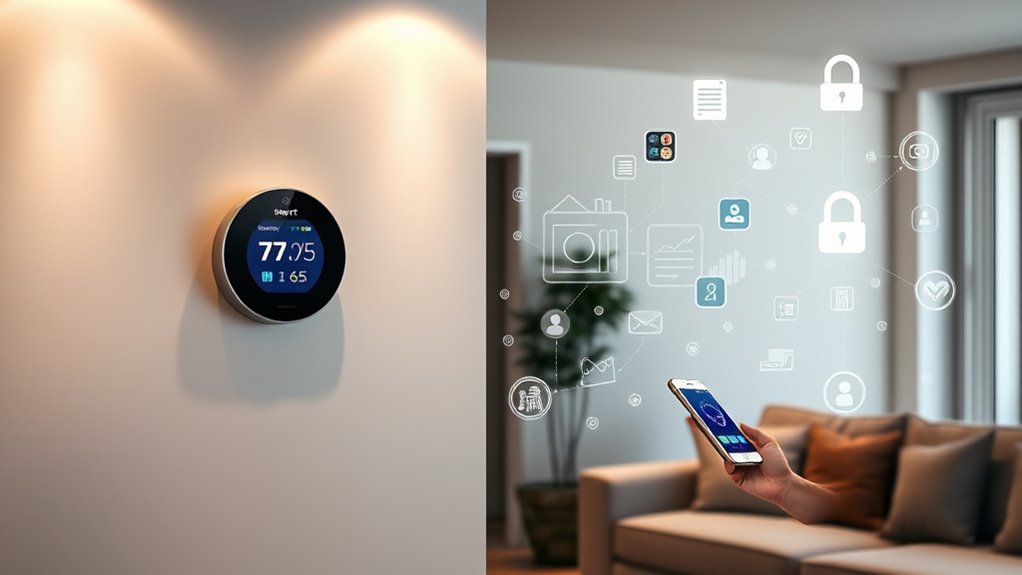
Smart thermostats analyze the data they collect to automatically adjust your home’s temperature for maximum comfort and efficiency. They learn your schedule, preferences, and habits to enhance your user experience while saving energy. By monitoring when you’re home or away, they optimize settings to reduce waste and lower bills. Imagine a table mapping your daily routine:
| Time of Day | Temperature Setting | Activity |
|---|---|---|
| Morning | 68°F | Sleeping |
| Afternoon | 72°F | At Work |
| Evening | 70°F | Relaxing |
| Night | 66°F | Sleeping |
| Away | 60°F | Not Home |
This data-driven approach creates a comfortable environment tailored to your lifestyle, maximizing energy efficiency and elevating your overall user experience. Additionally, understanding the privacy concerns associated with data collection can help you make informed decisions about device usage. It’s also important to recognize how data security measures are implemented to protect your personal information from potential breaches.
Potential Risks of Data Breaches and Unauthorized Access
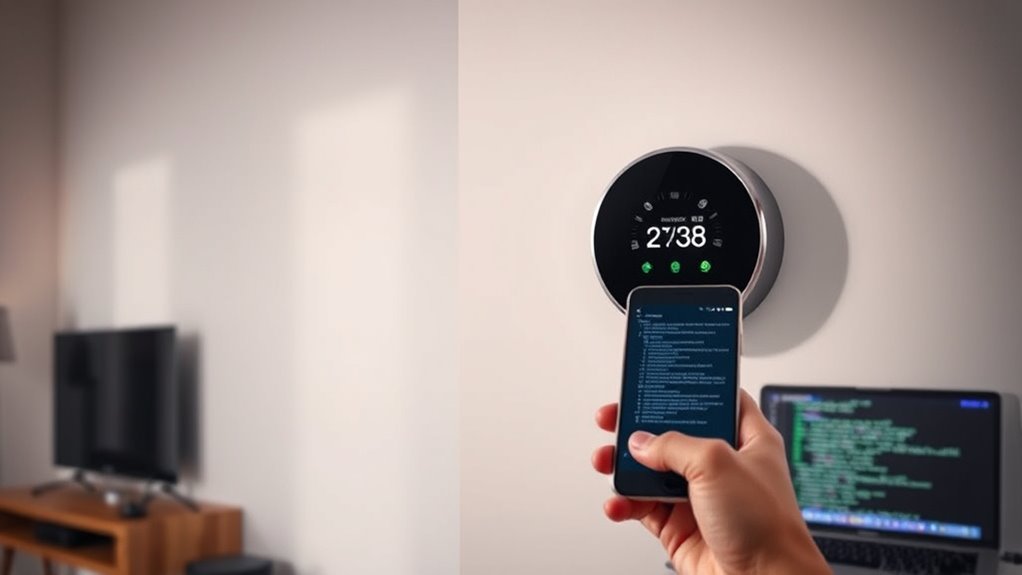
Your smart thermostat’s data could be vulnerable to breaches or hacking, exposing your personal information. Unauthorized access might allow intruders to control your device or gather sensitive details about your habits. Understanding these risks helps you take steps to protect your privacy and security. Additionally, being aware of relationship warning signs can help you identify potential issues in your digital interactions and safeguard your personal boundaries. Practicing mindfulness and presence can also improve your awareness of potential security threats and help you stay vigilant against suspicious activity. Recognizing the importance of secure network connections can further reduce the chances of unauthorized access to your smart devices.
Data Breach Vulnerabilities
One of the most significant risks associated with smart thermostats is the potential for data breaches that expose personal information. Hackers can exploit vulnerabilities in storage systems, risking access to sensitive data. Consider these points:
- Breaches can reveal your daily routines, occupancy patterns, and home security details.
- Attackers may access unencrypted data, increasing the risk of theft or misuse.
- Even when data is anonymized, breaches could re-identify users through pattern analysis.
- Properly encrypted storage and anonymized data reduce the impact but don’t eliminate vulnerabilities.
- Additionally, data protection measures practices demonstrate how rapid dietary changes can temporarily alter bodily functions, similar to how sudden data breaches can disrupt normal device operations.
- Understanding and implementing security protocols is essential for safeguarding your smart device ecosystem.
If a breach occurs, your personal habits and home details could be exposed, compromising your privacy. Staying aware of these risks helps you make informed decisions about your smart thermostat’s security measures.
Unauthorized Device Access
While data breaches can compromise personal information, unauthorized device access poses an immediate threat by allowing hackers to control your thermostat remotely. If your device lacks proper security measures, such as robust user authentication, hackers can gain entry and manipulate your settings. Ensuring device encryption is in place helps protect data transmitted between your thermostat and servers, making it harder for intruders to intercept and exploit. Without strong user authentication, your device remains vulnerable to unauthorized access. Hackers could disable security features, cause discomfort, or even use your device as a gateway to other parts of your network. To minimize these risks, regularly update firmware, use strong, unique passwords, and enable multi-factor authentication where available. Protecting your device’s security is essential to prevent unauthorized control and safeguard your privacy. Additionally, understanding AI vulnerabilities can help you stay informed about emerging threats and better safeguard your smart devices. Being aware of device security best practices can further enhance your protection against cyber threats. Maintaining awareness of common cyberattack techniques can also help you recognize potential threats early and respond effectively.

Sharing data from your smart thermostat with third parties can offer benefits like improved services and personalized experiences, but it also raises significant privacy concerns. When companies share your data, they often use third-party analytics to understand usage patterns or engage in data monetization, which involves selling or trading your information. Here’s what you should consider: 1. Third-party analytics may track your habits beyond your home. 2. Data monetization can lead to targeted advertising based on your temperature preferences. 3. Your data might be shared without clear consent or awareness. 4. Some companies may limit your control over how your data is used or shared. Additionally, the use of home decor elements like wall organization systems or stylish dinnerware in the home can influence how comfortable you feel with visible or shared data environments. Recognizing the privacy implications of data sharing helps you make more informed decisions about your smart home devices. Understanding these practices helps you decide whether sharing your thermostat data aligns with your privacy comfort level. Being aware of tea accessories and merchandise options and their branding can also help you recognize how companies might use familiar or aesthetic elements to build trust and loyalty in your smart home ecosystem.
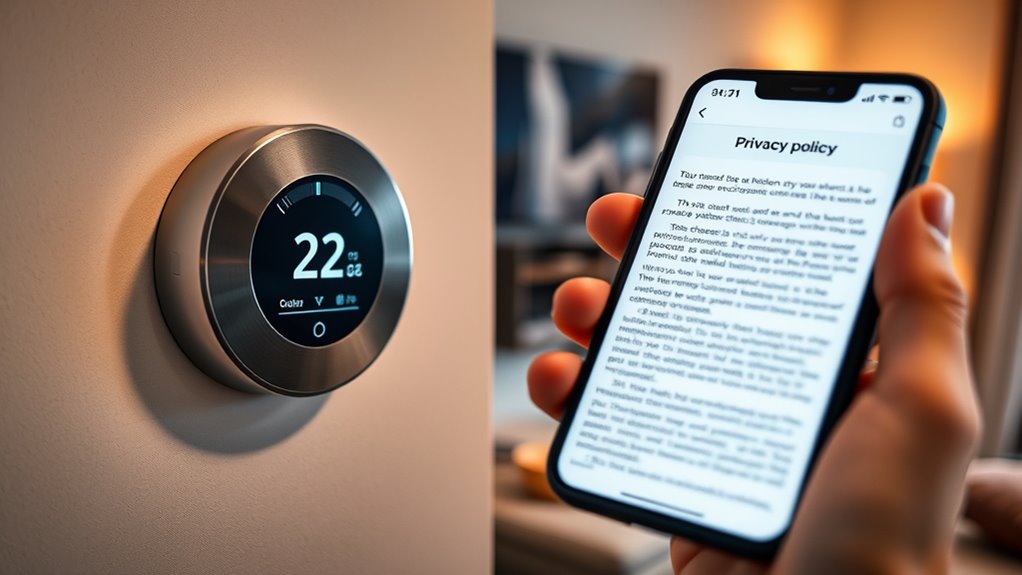
Understanding your smart thermostat’s privacy policies and user agreements is vital because these documents outline how your data is collected, used, and shared. Privacy policy nuances can vary widely, so it’s essential to read the fine print carefully. User agreement language often includes complex legal terms that clarify your rights and responsibilities. To help you navigate this, consider this overview:
| Aspect | What it Means | Why it Matters |
|---|---|---|
| Data Collection | Types of data gathered (usage, location, preferences) | Impacts your privacy |
| Data Sharing | Who gets access (third parties, advertisers) | Influences your data security |
| User Rights | Your options for data management and deletion | Empowers your control |
| Policy Updates | How updates are communicated | Ensures transparency |
| Consent Procedures | How you agree or opt out | Affects your privacy choices |
Additionally, understanding privacy policies can help you make informed decisions about your smart thermostat usage, especially when considering the data collection practices involved. Being aware of neuroscience principles related to privacy can further enhance your understanding of how your data might be processed and protected.
Strategies for Protecting Your Privacy When Using Smart Thermostats
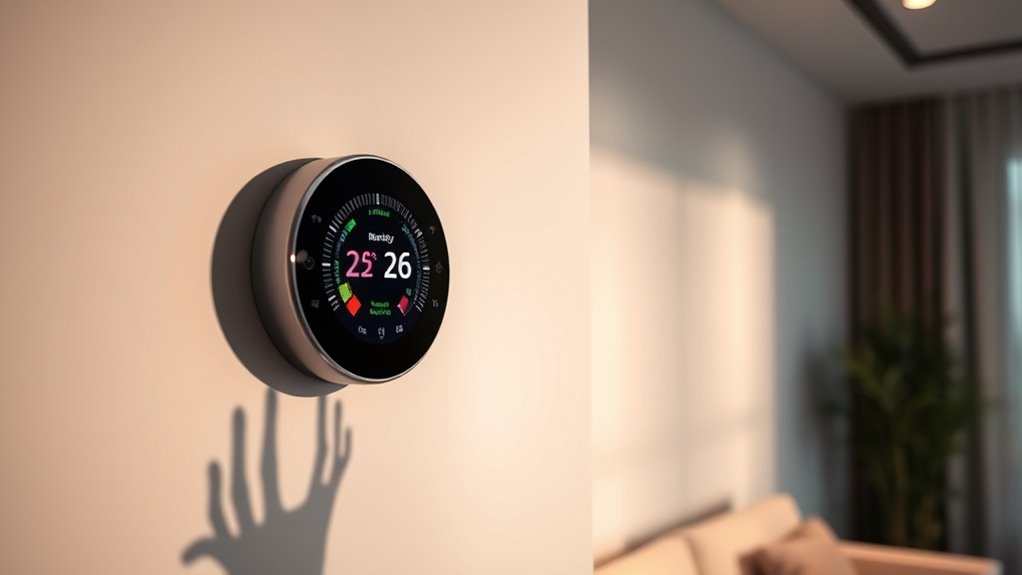
To protect your privacy, start by securing your Wi-Fi network with a strong password and encryption. Limit the amount of data your smart thermostat shares with manufacturers, and regularly install software updates to patch vulnerabilities. These steps help keep your personal information safe while you enjoy the convenience of smart technology. Additionally, consult privacy policies and user agreements before connecting your device to understand how your data is managed. Being aware of the trustworthiness of the brand can also help ensure your data is handled responsibly.
Secure Wi-Fi Networks
Securing your Wi-Fi network is essential to protect your privacy when using a smart thermostat. Start by enabling network encryption, like WPA3, to safeguard data transmitted between your thermostat and router. Next, set a strong, unique password for your Wi-Fi to prevent unauthorized access. Use device authentication features to verify devices connecting to your network, ensuring only trusted gadgets can communicate. Additionally, regularly update your router’s firmware to patch security vulnerabilities. Finally, consider hiding your Wi-Fi network’s SSID to make it less visible to potential intruders. These steps help create a secure environment, reducing the risk of data breaches and unauthorized monitoring of your smart thermostat. Prioritizing network security keeps your personal information safe and your smart home private. Implementing comprehensive security measures also addresses cybersecurity vulnerabilities, which can be exploited during outages or targeted attacks.
Limit Data Sharing
Are you aware of how much personal information your smart thermostat shares with manufacturers and third parties? Limiting data sharing is vital for protecting your privacy. Check your device settings to disable unnecessary data collection and sharing options. Many thermostats allow you to opt out of sharing usage data or location info, reducing privacy risks. Keep in mind, privacy limitations vary by manufacturer and model, so review privacy policies carefully. Some devices may still gather essential data for functionality but restrict third-party access. Use the table below to compare data sharing practices:
| Feature | Privacy Limitation |
|---|---|
| Location sharing | Turn off or limit sharing |
| Usage data collection | Opt out if possible |
| Third-party integrations | Disable unneeded connections |
| Voice data | Delete stored recordings |
| Data sharing with manufacturers | Set restrictions or opt out |
Reducing data sharing helps safeguard your information effectively.
Regular Software Updates
Keeping your smart thermostat’s software up to date is a key step in protecting your privacy. Regular updates address software vulnerabilities that hackers could exploit to access your data. To maximize protection, consider these steps:
- Check for updates frequently—at least once a month.
- Enable automatic updates if available, ensuring you don’t miss critical patches.
- Review update notes to understand what security improvements are included.
- Keep your device’s firmware current to prevent known vulnerabilities from being exploited.
Consistent update frequency reduces the risk of security gaps. Manufacturers often release patches for emerging threats, so staying current is essential for safeguarding your personal information and maintaining privacy.
Features and Settings That Enhance Data Security
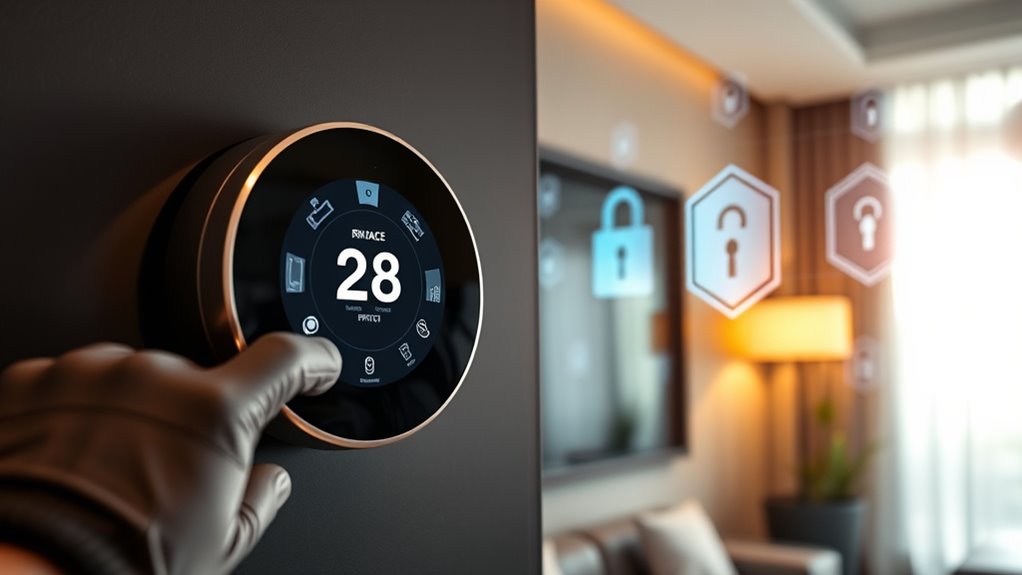
To protect your personal data, smart thermostats offer features and settings designed to enhance security. You can enable two-factor authentication, which adds an extra layer of protection against unauthorized access. Adjusting privacy settings helps limit data sharing, and disabling voice recognition prevents sensitive information from being stored. Some thermostats allow you to monitor and control energy consumption, reducing the risk of data leaks related to usage patterns.
| Feature | Benefit |
|---|---|
| Voice recognition | Protects sensitive commands and data |
| Two-factor authentication | Adds security against hacking |
| Privacy controls | Limits data sharing and storage |
Manufacturers’ Approaches to Privacy and Data Management
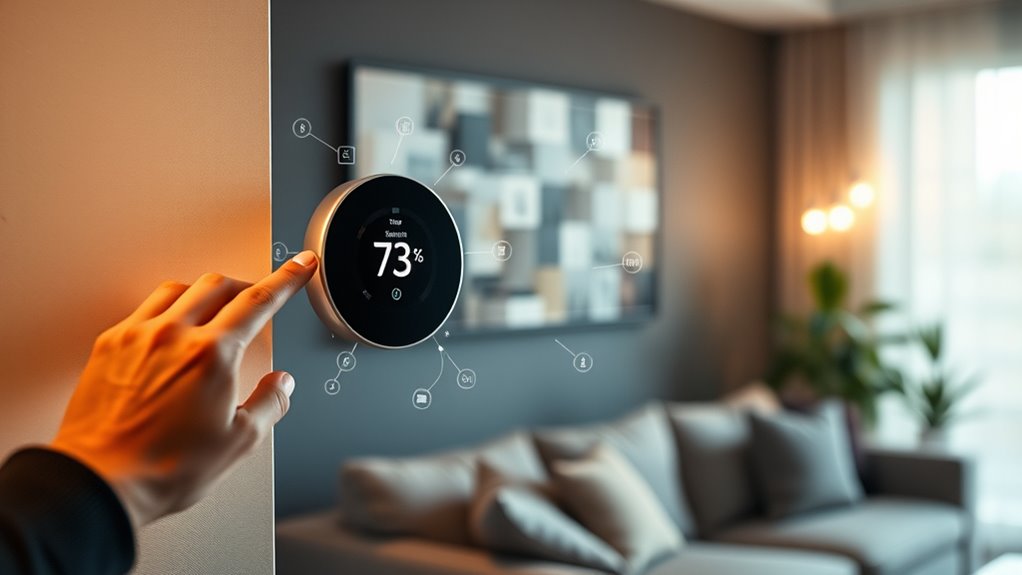
Manufacturers vary in how they approach privacy and data management, affecting how your information is handled. They often detail their data collection practices and privacy policies, but the clarity of this information can differ. Understanding how much control you have over your data is key to making informed choices about smart thermostat use.
Data Collection Practices
While smart thermostat manufacturers often emphasize energy savings and convenience, their data collection practices reveal a complex approach to privacy. They gather various types of information, including:
- Voice commands, which capture your spoken instructions for device control.
- Usage patterns, helping improve energy analytics and optimize heating and cooling schedules.
- Location data, tracking your presence to adjust temperature settings automatically.
- Connectivity data, recording how your device interacts with other smart home systems.
This data allows manufacturers to enhance features and personalize experiences but also raises privacy concerns. They often collect detailed insights into your habits, routines, and preferences, sometimes sharing this information with third parties. Understanding these practices helps you make informed decisions about your privacy.
Privacy Policy Transparency
Many smart thermostat manufacturers have begun to recognize the importance of clear and accessible privacy policies, but their approaches vary widely. Some prioritize privacy policy clarity, making their policies straightforward and easy to understand. Others focus on transparency reporting, regularly updating users about how data is managed and shared. This variation affects your ability to assess privacy risks effectively. Some companies provide detailed summaries, while others bury critical information in lengthy documents. To help you compare, here’s a quick overview:
| Approach | Example |
|---|---|
| Privacy Policy Clarity | Simplified language, summaries |
| Transparency Reporting | Regular updates, data sharing logs |
Understanding these differences helps you better evaluate how much control and insight you have over your data.
User Data Control
How much control do you actually have over your data when using a smart thermostat? Manufacturers vary in how much user autonomy they allow. Some provide options to:
- Adjust privacy settings to limit data sharing
- Delete or export your personal data
- Opt out of data collection entirely
- Enable data anonymization to protect your identity
While these features give you some control, others may restrict access or make it difficult to manage your information. Many companies focus on data anonymization to safeguard your privacy, but full control isn’t always guaranteed. Your ability to manage your data depends on the manufacturer’s approach and transparency. Ultimately, understanding these options helps you make informed choices about your privacy and data management.
Future Trends and Emerging Privacy Challenges in Home Automation
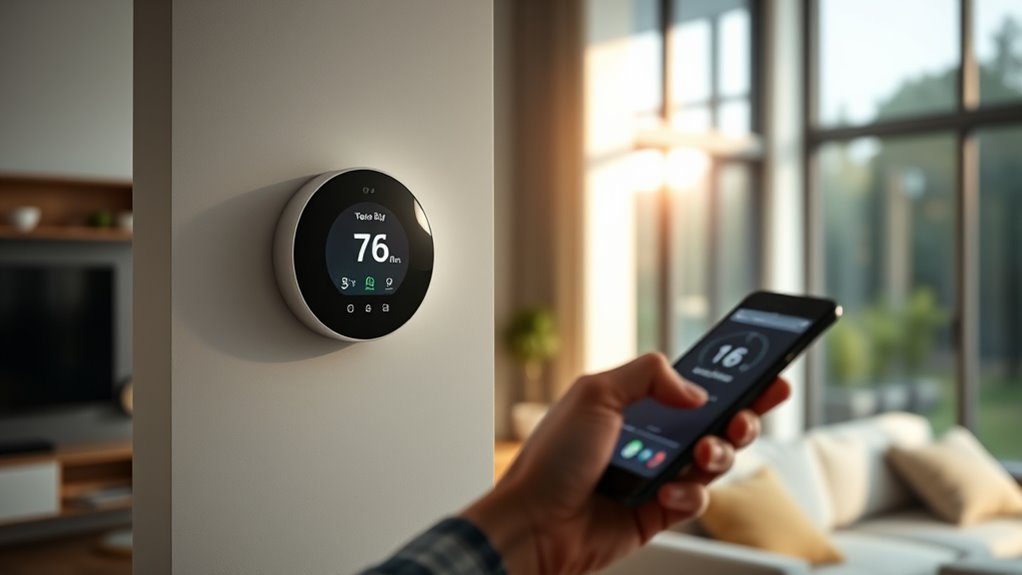
As home automation technology continues to evolve, emerging privacy challenges are becoming more complex and pressing. AI integration allows devices to learn your habits, but it also raises concerns about data misuse and unintended profiling. As smart systems get smarter, the risk of unauthorized access or data breaches increases, making privacy protection harder to maintain. Regulatory oversight is expected to tighten, but keeping pace with rapid innovations remains a challenge. You’ll need to stay informed about new laws and best practices to safeguard your personal information. Future trends suggest a focus on transparency, better data controls, and stronger security measures. However, balancing convenience with privacy will require ongoing vigilance as home automation becomes more sophisticated.
Frequently Asked Questions
Can I Completely Disable Data Sharing on My Smart Thermostat?
You can often disable data sharing on your smart thermostat, but it depends on the device and manufacturer. Check your settings for options related to user consent and privacy. Confirm data encryption is enabled to protect your information. While some manufacturers allow you to fully disable data sharing, others might limit this option, so review the privacy policy carefully. Always stay updated on your device’s privacy settings to maintain control over your data.
How Long Do Manufacturers Retain My Personal Data?
Manufacturers typically retain your personal data based on their data retention policies, which vary by company. You should review their privacy commitments to understand how long they keep your information. Some may retain data for as long as necessary to provide services or comply with legal obligations, while others might delete it sooner. Always check your thermostat’s privacy settings and manufacturer policies to stay informed and manage your data effectively.
Are There Any Legal Protections for Smart Thermostat Users’ Privacy?
You’re protected by laws that require manufacturers to prioritize your privacy. These regulations often mandate data encryption to secure your information and require your explicit user consent before collecting or sharing data. You have rights to access and control your data, ensuring your privacy is respected. Always review privacy policies, and remember, reputable companies implement strict safeguards like data encryption to protect your information from unauthorized access.
What Are the Signs of a Privacy Breach Related to Smart Thermostats?
Imagine noticing your smart thermostat suddenly changes settings or responds to commands you didn’t give. That’s a sign of a privacy breach, likely due to unauthorized access. You might also see suspicious activity in your account, like unfamiliar devices or strange login locations. These signs indicate someone has tampered with your device or accessed your data without permission, making it essential to monitor activity and strengthen your security measures.
Do Smart Thermostats Collect Data When the House Is Unoccupied or Offline?
When your smart thermostat is unoccupied or offline, it may still collect data like temperature preferences and usage patterns. However, reputable models use data encryption to protect this information, and manufacturers often require your user consent before data collection begins. This means your privacy is prioritized, but it’s crucial to review privacy settings regularly and confirm you’re comfortable with what data is being gathered, even when you’re not actively using the device.
Conclusion
As you embrace smart thermostats, remember that over 80% of users are concerned about data privacy. Protecting your personal information is vital as these devices collect detailed insights about your daily routines. By understanding their data practices, using security features, and staying informed about evolving privacy challenges, you can enjoy the convenience without compromising your privacy. Stay vigilant and proactive to guarantee your smart home remains both comfortable and secure.
